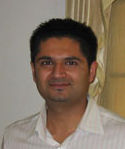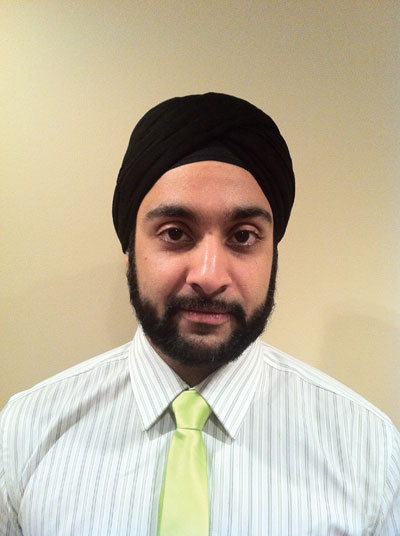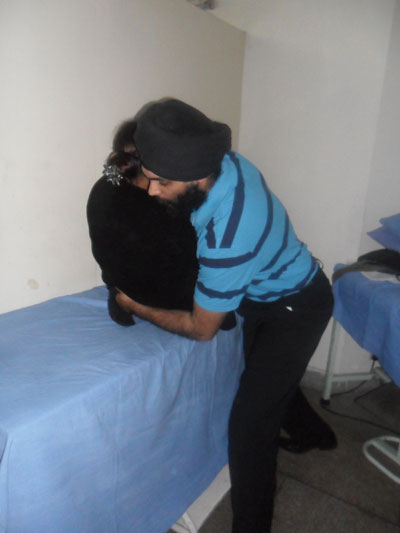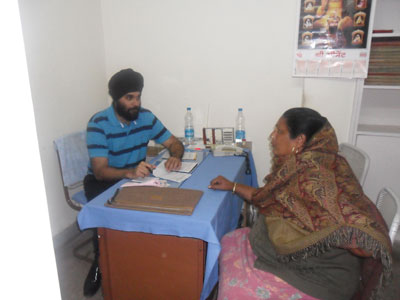
Chiropractic in India
By By members of the IACD and Preetkamal Randhawa DC
Features Leadership ProfessionIn 2011, India is recognized as one of the fastest growing economies in Asia, and stands as the world’s largest democracy.
In 2011, India is recognized as one of the fastest growing economies in Asia, and stands as the world’s largest democracy. As well, the country boasts a large English-speaking population. But India only has four full-time chiropractic clinics in operation, staffed by three chiropractic doctors and many other members in North America. How did this happen? How did one of the biggest trading partners in the world, in a land known as a fertile ground for alternative healing, suddenly get left behind in one of the biggest breakthroughs in non-medicinal and non-surgical healing – namely, chiropractic?
Dr. Amit (Jimmy) Nanda has tackled this issue right on the spot. Now recognized as the founder of chiropractic in India, in 2001, Dr. Nanda was an Indo-Canadian student at Life Chiropractic College West. While preparing for graduation, he was inspired to reconnect with his roots in India, and began making frequent visits to his family there. During these visits, he came to the realization that there were no chiropractors in the entire country, nor had the masses even heard of chiropractic. India had seen tremendous advances in the health-care industry: there were foreign companies opening hospitals all over, state-of-the-art labs were being open with the latest equipment and medical tourism had begun to rise. Physiotherapy was becoming a driving force in manual therapy treatments throughout the country. In terms of alternative health care, the majority of the masses were invested in yoga, Ayurveda, homeopathy, and acupressure. But allopathic medicine continued to dominate the health-care industry – the masses perceived the words of big hospital directors as gospel to guide their present and future lifestyle and health-care choices. But, in the midst of all this, where were the chiropractors?
Prior to this period during which Dr. Nanda observed the lack of chiropractic in India, most chiropractors had come to the country only on temporary mission trips; no one had ever stayed to establish the profession within India’s massively growing health-care system. Upon returning to North America, Dr. Nanda was determined to change this situation.
BIRTH OF A SOLUTION
Before his graduation from chiropractic school, Dr. Nanda busied himself in seeking the guidance of those who were familiar with the process of establishing chiropractic in a foreign country. From his research, the concept of the Indian Association of Chiropractic Doctors (IACD) was formed. The IACD was established as an organization whose aim is to develop chiropractic in India and ensure that those who wish to practice there receive, or have already undergone, proper education and training – it stands as the only organization with this mandate in India. The organization is chartered under the World Federation of Chiropractic (WFC), and currently has a proposal submitted to the government of India for legislation.
After the IACD had been established, Dr. Nanda and the group of DCs who now shared his vision, were charged with setting up a board. Dr. Ricky S. Rana, an Indo-Canadian graduate of Southern California University of Health Sciences, who became the newly elected vice-president of the IACD, joined Dr. Nanda on the quest to bring chiropractic to India. The two DCs attended various WFC events to gain greater insight into the job they were undertaking as well as to establish a presence for the country of India. They also met with government and medical officials in India.
On March 22, 2006, the IACD was officially launched in India in a press release before a news conference team at the Grand Intercontinental Hotel in New Delhi, with the Minister for Health, Family Welfare and Social Welfare, Dr. Yoga Nand Shastri, as the guest speaker. The event was a success, announcing chiropractic as an established form of health care that was now available in India.
OPPORTUNITIES AND CHALLENGES
Since its inception, the IACD has held charitable dispensaries at many events in India. Through these, and continuing missions carried out by a number of DCs, chiropractic care is increasingly being provided to the masses in need. The IACD will be assisting in this growth as well as overseeing the development of future chiropractic education and training programs in India.
The organization also plans on working to attract the many Indians in Canada to reconnect with their own roots, and to come help establish chiropractic as a mainstream health-care profession in India. The IACD is also in talks to develop and assist in starting the first accredited chiropractic program in a university in India.
The IACD board and membership currently consists of Canadian, American, and Australian chiropractors as well as medical doctors from Canada and the U.S. who believe that there is a need for chiropractic in India. Along with these, the IACD is also working with very prominent surgeons in India who are pushing to expedite legislation for the profession there.
But, of course, bringing chiropractic to India has not been without challenges. The public lacks awareness with respect to the chiropractic profession. As well, there are some therapists who say they can perform “chiropractic” but have had inadequate or no training. This has resulted in confusion and misrepresentation of what chiropractic is about. Fortunately, and with the assistance of the medical board and government authorities, the IACD has been able to shut down the clinics of therapists who, after taking a weekend course, or viewing videos about adjusting online, call themselves chiropractors. As well, the IACD wishes to record the presence and actions of all legitimate chiropractors who practise in India, in order to promote the profession to the government while protecting the DCs and ensuring safe care is offered to all patients.
HOW YOU CAN HELP
Given the challenges already faced in trying to establish chiropractic in another country, the IACD encourages all DCs and students who wish to undertake mission trips to India to register prior to embarking on their trip. By endorsing and recording the progress of legitimate chiropractors, the IACD will be able to enhance the credibility of the profession to the government and health-care authorities, thus ensuring that the legislation process proceeds smoothly. But also, if the IACD is not made aware of a chiropractic mission trip – and, especially if a complaint is lodged – the IACD will be unable to promote and/or protect the doctors and students who are involved. By informing the IACD of your plans for a chiropractic mission trip in India, you can assist in keeping the legislation process intact, and ensure that DCs are protected and that patients are safe. To contact the IACD, please e-mail info@indiachiropractic.com.
THE IACD Board
 |
|
| Dr. Amit (Jimmy) Nanda, President, Indian Association of Chiropractic Doctors |
Dr. A.J. Nanda, President
Dr. Nanda completed his Doctor of Chiropractic from Life Chiropractic College in 2003. He founded the IACD and has been tirelessly working with the board to lay the foundation for legislation in India.
 |
|
| Dr. Ricky S. Rana, Vice President, Indian Association of Chiropractic Doctors |
Dr. R. Rana, Vice-president
Dr. Rana lives in Edmonton, Alberta. He completed his doctor of chiropractic and his master’s in acupuncture and oriental medicine from Southern California University of Health Sciences in 2003. He has served as the vice-president of the Indian Association of Chiropractic Doctors since 2005 and continues to be active in laying the foundation for chiropractic in India.
Dr. N. Arora, Secretary
Dr. Arora graduated from Life University in 2000. He has successfully practised chiropractic for many years and is also a cofounder of a chain of chiropractic clinics. Dr. Arora has been very active in ensuring that India is exposed to the chiropractic profession in a responsible manner.
Dr. B. Sohal MD, Treasurer/Communications Officer
Dr. Sohal is a Canadian medical doctor and practices as a family physician in Toronto. He also has two walk-in and family practices. Dr. Sohal has always believed in the benefits of chiropractic and, as an Indo-Canadian, he has dedicated himself to ensuring that India has the same type of care that is available in North America.
Dr. V. Jain, MD, Ortho Surgeon – Medical Advisor/Government Relations
Dr. Jain is an orthopedic surgeon in New Delhi, India, and a member of various medical boards in India. He frequently travels between India, Canada, and the United States. He has converted a wing of his own hospital to a chiropractic wing. Dr. Jain is in the process of becoming a chiropractor, himself. When he completes his training, he will be the first MD/DC in India. He feels that chiropractic is the missing piece in the Indian health system and he aspires to help change that.
Providing Sewa to Those in Need – One DC’s Mission to India
By Preetkamal Randhawa, DC, member IACD
My wife and I had the pleasure of visiting India from March 3 to 18, and for four days during our trip, we had the opportunity to provide chiropractic care to the needy who could not afford quality health care of any sort. We had been invited by the Guru Nanak Mission Hospital administration, a charitable hospital in the city of Jalandhar, Punjab. The hospital had issued press releases in the local newspaper weeks in advance of our arrival and the response was tremendous.
 |
|
| Dr. Preetkamal Randhawa adjusting a patient at Guru Nanak Mission Hospital in Jalandhar, Punjab. |
Day 1
On our first day, the intent was to do as many consultations as we could, making sure that we understood the patients’ situations, and explain to them exactly what we do and how it could help them. We saw many different cases, and a lot of the patients who had tried everything in the world. Most of these patients presented with back pain and/or sciatica, and some of those had already been scheduled for surgery. We found that many of the people who came to us were already quite open to the idea of chiropractic – a fact that made our endeavours somewhat easier. In total, on this first day, approximately 200 patients lined up and waited for us to see them. Of course, it was impossible to see them all – but we tried our best and saw as many as we could.
One response that we kept hearing from many of these patients was that this was the first time someone actually took the time out to listen to them!
Day 2
On the second day, we were scheduled to see more new patients in the morning, and then begin our treatments in the afternoon. Again we had another 200 folks line up to be seen, and again it was impossible to see them all. I was told that everyone found out that there was a doctor in town who really listened to your problems! I was flattered by all the nice comments we received and this actually made me realise how lucky we are to do what we do.
 |
|
| Hopeful patients who came to see the chiropractic doctor were impressed with how attentively he listened to them. |
By the end of the morning, we had decided not to take any new patients because we would not be able to give them the quality time that they deserved. I believe that someone deserves your time, so that you can provide them with the quality of health care that they deserve. In the end, the total number of patients that we decided to treat was 102.
As planned, we began with our chiropractic treatments in the afternoon. To be honest, I was, at first, worried regarding how people would respond to chiropractic – but people responded well to our care! One thing that was for sure was that they had never had their bodies treated like this before. They had mostly relied on painkillers, physiotherapy, massage or herbal remedies.
By 9 p.m. we had seen everyone . . . and trust me . . . the hospital treatment bed looked so good to sleep on after this long work day! But our patients were responding well and they were pleased with the treatment they had received – so we felt as though it had all been well worth the effort!
Day 3
On the third day, we saw everyone for their second treatment. Each patient walked in with big smiles – people were starting to feel better. Some even had tears in their eyes because they never thought that they would be pain-free again! Some patients who had not lived a day without pain for years reported that, for the first time, they could walk and sit pain free. Some even brought others to be treated, but we had to turn them away because we were already at our maximum capacity.
So, it was another long day, but I enjoyed every minute of it. It was a nice feeling to be making a difference.
Day 4
On our last day, everyone came in for their last treatments and although we were not able to provide everyone with our full program, we were able to make a difference in their health.
One patient, in particular, really touched my heart. He is a night watchman at a factory, and earns only 500 rupees a month – that is about $12 Canadian. He had been living in pain for the last 10 years following an accident, and he had a steel rod implanted in his leg. He had tried everything to reduce the pain, and basically I was a glimmer of hope for him. I didn’t know how much I could help him, to tell you the truth, but we tried our best. After three treatments, he said he felt 80 per cent better – and he could actually walk and sit. Before he left, he actually broke down and cried, and even brought tears to my eyes. It was a nice feeling, something that cannot really be described!
Epilogue
I wish I could have stayed longer, to offer full treatment plans to our patients as well as to see more patients! It was distressing to see how many people were in pain, but it was amazing to realize how chiropractic could really help them. We could not see everyone who came to us, but I am glad we could help those we did see. One thing I learned was that there is a need for structural chiropractic in the world.
I have been in practice for the past six years, and I am thankful to the staff at Guru Nanak Mission Hospital for giving me this life-changing experience.
Print this page